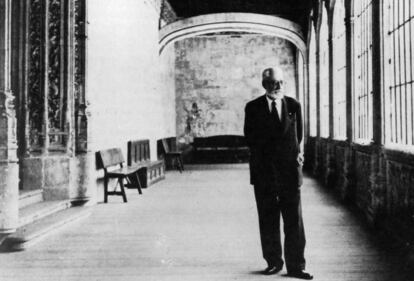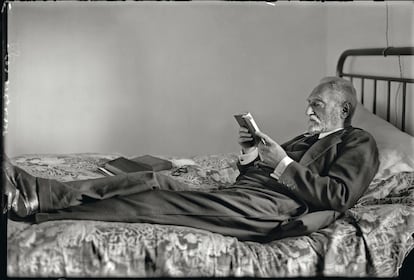The words “conquer and convince” pronounced by Miguel de Unamuno in the auditorium of the University of Salamanca in October 1936 have caused rivers of ink to flow. What words did the rector say exactly and what was the reaction of those present and of Millán Astray? The professor was referring to the difference between winning with weapons and convincing with reason. Much has been said about that day in the auditorium but, on the other hand, we know almost nothing about a lost letter that the rector wrote two months later and that could be interpreted as his ideological testament. This document has remained unknown because the letter never left Salamanca nor was it ever published with the signature of the Basque writer. An interview recorded at the Madrid Residencia de Estudiantes in 1998 with a witness to the events, the Spanish-Soviet engineer Manuel Vicens González, provides the key to recovering echoes and fragments of that lost letter, which has now been partially reconstructed and illustrates an essential moment in the rector’s life.
When the Civil War broke out, Manolo Vicens was eight years old and was in Salamanca with his mother and aunts. At the end of the nineties, after living in Russia almost all his life, he spoke in impeccable Spanish about his parents and about the donation of the family archive to the Residencia. In that conversation, and in an interview published in EL PAÍS, Vicens mentioned the letter that Unamuno had given to his mother to take her out of Spain. María Luisa González Rodríguez was a librarian from Burgos, she had been Unamuno’s student and protégé in Salamanca and both she and her sisters had a close friendship with the professor and his daughters, forged during the summers of both families in Becedas (Ávila). The rector of Salamanca trusted his student and had a long conversation with her before entrusting her with the letter, which was addressed “to the owners of the hotel in Hendaya where he had lived during his exile” in the time of Primo de Rivera. Shortly afterwards, María Luisa fled Salamanca with her children in a taxi in the early hours of the morning.
Manuel Vicens recalled the tense preparations for the march. His aunts argued at length about the matter and convinced María Luisa not to take the letter with her for fear that, if intercepted, it could cost the rector jail for his unequivocally anti-Franco stance. The librarian opted to learn the most important passages by heart, pacing the corridor while studying and tirelessly repeating the text. When María Luisa and her husband—the Aragonese librarian Juan Vicens—met in Irún to cross the border together, they decided to deal with the situation by taking notes of the passages she had filed away in her brain.
The transmission of Unamuno’s ideas was an active exercise in historical memory. Manuel Vicens provides the key to finding this new data by mentioning a newspaper clipping with information taken directly from the letter from Salamanca. The text functions as a copy made by a scribe who captures the events narrated by a troubadour. Juan Vicens had written an article where he collected fragments, ideas and memories of Unamuno from the letter entrusted to María Luisa.
A reference by Ramón Salaberría, biographer of Juan Vicens, has allowed us to unearth that article that has not been studied until now and that was published in 1945 in the Mexican magazine Aragon with the unequivocal title Unamuno and Francoism. By then the couple was separated by exile: María Luisa lived in Moscow with her children and Juan Vicens in Mexico. In that article, the librarian took precautions to conceal the identity of his wife—a smuggler of ideas—and of the custodians of the original letter, which “is safely in Salamanca and will one day see the light.” The lack of transparency reveals his efforts to protect his wife and the guardian of the letter, who must have been María Luisa’s older sister, Felisa González, who had been imprisoned twice and was trying to survive the suffocating embrace of Francoist repression in Salamanca.

Juan Vicens’ article explains that in December 1936 Unamuno spoke and confided his letter to “a lady whom I know very well and with whom I spoke at length at the time. She had been a student of Unamuno and there was a close friendship between her family and his.” He also explains that “a member of the lady’s family collected the letter from her, fearing that it would be found in the customs register.” Vicens thus became the executor of the rector’s ideas, transmitting from exile the notes taken years before.
In his writing he shares that Unamuno harshly attacked the Francoists, whom he accused of being “a band of illiterate idiots who were plunging Spain into shame and stupidity”, he quotes his exact criticism of the “cold, methodical, scientific and sadistic Francoist repression” and tells that the rector had called a university librarian a “buffoon” for wearing the Falangist shirt and cap. The article also explains that Unamuno had sent a letter to Luca de Tena, director of the newspaper ABC of Seville, expressing his horror at the unbearable sight of “the pious ladies and young ladies who came in the mornings with unhealthy pleasure to contemplate the corpses of the leftists walks by the Falangists.”
Juan Vicens’ words have also allowed us to locate a previously unknown testimony, written in 1961 by María Luisa herself on the occasion of the anniversary of her mentor’s death. It was published in Brussels in the magazine Our Ideas with the title Reminder notesand its author presents herself as an “eyewitness” of those events and tells that, after the events at the university, signs were placed in the shop windows of the Plaza Mayor in Salamanca with the message “It is forbidden to talk about what happened in the auditorium” that incited the opposite. The librarian reveals that the Falangist writer Eugenio Montes had shown up at Unamuno’s house to visit him with the excuse that they shared the same ideas and that he had closed the door after telling him “but do you know what it is to have ideas?”, and expresses dismay that Don Miguel’s coffin was carried on the backs of Falangists who were wearing the hated attire. She also remembers that she went to ask him for help to get a passport, but Unamuno replied that he could do nothing for her because “if I recommend her, they will shoot her.”
He tells of his last interview with his teacher on December 17: “He talked about the crimes and atrocities (…) He told me how he wrote to everyone so that they would know what was happening there. He asked me to go and see Marañón and Ortega in Paris and to talk to them about the situation and his attitude towards it. He told me: ‘Tell them not to come, this is a fierce collective madness.’” The quotes from that letter, which was kept, copied and cited in fragments, shed a light whose brightness is superimposed on the events in the auditorium. The letter that the González Rodríguez sisters kept under lock and key in Salamanca will probably never appear, but these writings and memories of the Vicens González couple illuminate Unamuno’s position in his last days. His disciple dismisses the rumour that the writer was murdered by the Falangists, but vehemently declares “that his life was shortened and his end hastened by the tremendous pain he felt for Spain, which he saw in such a bad state.”

